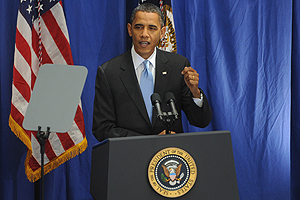Government & Politics
Scholar's “13 Keys” Predict Another Obama Win

Although the next presidential election is 28 months away, President Barack Obama's reelection in 2012 is nearly guaranteed despite former House Speaker Newt Gingrich’s prediction that Obama has only a 20 percent chance, according to American University Professor Allan Lichtman. Lichtman’s “13 Keys” system predicts the outcome of the popular vote based on the performance of the party and not the use of candidate preference polls, campaign tactics, or events.
“Nothing that a candidate has said or done during a campaign, when the public discounts everything as political, has changed his prospects at the polls. Debates, advertising, television appearances, news coverage, and campaign strategies—the usual grist for the punditry mills—count for virtually nothing on Election Day,” says Lichtman.
Successful Track Record
The “13 Keys” featured in Allan Lichtman’s renowned book Keys to the White House, have been highlighted in dozens of articles throughout the world and are a resource for aspiring politicians. The “13 Keys” are conditions that favor reelection of the incumbent party candidate. When five or fewer are false, the incumbent party candidate wins. When six or more are false, the other party candidate wins.
According to Lichtman, the passage of the health care bill counts as a positive for the Democratic Party, leaving the party with only four keys likely turned against it for 2012—two short of the fatal six negative keys. With nine keys that currently favor the incumbent party, Lichtman says President Obama could endure an additional setback, such as the recent political fallout from the oil spill in the Gulf of Mexico, and still be reelected.
In 2007, with the presidential election more than a year out and neither party with a chosen nominee, Lichtman declared that the Democrats would retake the White House no matter which candidate—Barack Obama, Hillary Clinton, or John Edwards—captured the Democratic nomination.
Lichtman’s “13 Keys” system predicted George W. Bush's 2004 reelection as early as April 2003, Al Gore’s popular vote victory in 2000, Bill Clinton’s win in 1996, George Bush’s defeat in 1992, and the outcome of the 1988 presidential election when Michael Dukakis was well ahead in the polls.
Outlining the Keys:
• KEY 1 (Party Mandate): After the midterm elections, the incumbent party holds more seats in the U.S. House of Representatives than it did after the previous midterm elections. (FALSE)
• KEY 2 (Contest): There is no serious contest for the incumbent-party nomination. (TRUE)
• KEY 3 (Incumbency): The incumbent-party candidate is the sitting president. (TRUE)
• KEY 4 (Third party): There is no significant third party or independent campaign. (TRUE)
• KEY 5 (Short-term economy): The economy is not in recession during the election campaign. (TRUE)
• KEY 6 (Long-term economy): Real per-capita economic growth during the term equals or exceeds mean growth during the previous two terms. (FALSE)
• KEY 7 (Policy change): The incumbent administration effects major changes in national policy. (TRUE)
• KEY 8 (Social unrest): There is no sustained social unrest during the term. (TRUE)
• KEY 9 (Scandal): The administration is untainted by major scandal. (TRUE)
• KEY 10 (Foreign/military failure): The administration suffers no major failure in foreign or military affairs. (TRUE)
• KEY 11 (Foreign/military success): The administration achieves a major success in foreign or military affairs. (FALSE)
• KEY 12 (Incumbent charisma): The incumbent-party candidate is charismatic or a national hero. (FALSE)
• KEY 13 (Challenger charisma): The challenging-party candidate is not charismatic or a national hero. (TRUE)
A Proven Track Record
“The Keys show that elections are not horse races in which candidates surge ahead or fall behind on the campaign trail, with pollsters keeping score,” says Lichtman. “Rather, a pragmatic American electorate chooses a president according to the performance of the party holding the White House as measured by the consequential events and episodes of a term — economic boom and bust, foreign policy successes and failures, social unrest, scandal, and policy innovation.”
Allan Lichtman has published six other books, most recently a study of the origins, evolution, and triumph, at times, of modern conservatism in White Protestant Nation: the Rise of the Modern American Right. In a comprehensive blueprint of conservatism since the post World War I era, he connects the roots and tactics of modern conservatism to the 1920s.